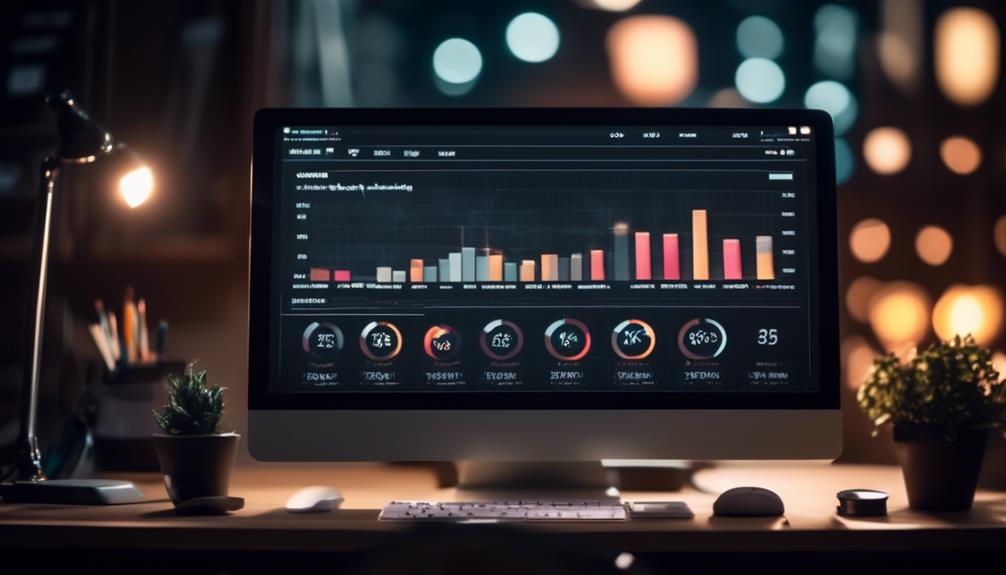You might not be aware that developing an effective email marketing strategy involves more than just crafting compelling content. Did you know that understanding your target audience plays a crucial role in driving engagement and conversions? By taking the time to delve into the intricacies of your audience’s preferences, behaviors, and pain points, you can tailor your email campaigns to resonate with them on a deeper level. This initial step sets the foundation for a successful email marketing strategy, but it’s just the beginning of a comprehensive process that can elevate your brand’s reach and impact.
Involving a Virtual Assistant
To streamline your email marketing efforts, consider enlisting the assistance of a virtual assistant. Virtual assistant benefits are numerous when it comes to managing your email marketing strategy. These professionals can help you save time, increase productivity, and ensure that your campaigns are effectively executed. By delegating tasks to a virtual assistant, you can focus on high-level strategic decisions while they handle more routine activities like scheduling emails, managing subscriber lists, and analyzing campaign performance.
When working with a virtual assistant, it’s essential to provide clear instructions and guidelines to ensure they understand your brand voice and messaging goals. Communication is key, so establish regular check-ins to discuss progress, provide feedback, and address any concerns. Additionally, trust your virtual assistant to take ownership of their responsibilities and empower them to make decisions within their scope of work.
Understanding the Target Audience
Understanding your target audience is crucial for developing a successful email marketing strategy. To effectively reach your audience, consider the following key points:
- Audience Segmentation:
- Identify different segments within your target audience based on factors such as demographics, interests, and behaviors.
- Tailor your email content and messaging to cater to the specific needs and preferences of each segment.
- Personalization:
- Utilize data from demographic analysis and behavior tracking to personalize your emails.
- Address your subscribers by their name, recommend products based on their past purchases, or send targeted offers that align with their preferences.
Setting Goals
To excel in email marketing, you must first define clear objectives that align with your overall business goals. By establishing measurable targets, you can gauge the effectiveness of your email campaigns and track progress towards your desired outcomes. Setting precise goals ensures that your email marketing efforts are strategic and purposeful, leading to higher engagement and conversion rates.
Define Clear Objectives
Setting clear objectives is crucial for developing a successful email marketing strategy. When defining your objectives, consider goal setting and audience analysis to ensure your strategy resonates with your target audience. To align your objectives effectively, focus on objective alignment and outcome measurement. Here is a breakdown of these key points:
- Goal Setting:
- Clearly outline what you aim to achieve with your email marketing campaigns.
- Set specific, measurable, achievable, relevant, and time-bound (SMART) goals.
- Audience Analysis:
- Understand your target audience’s preferences and behaviors.
- Tailor your objectives to meet the needs and interests of your audience effectively.
Establish Measurable Targets
Establishing measurable targets in your email marketing strategy is essential for tracking progress and evaluating the success of your campaigns. By incorporating data analysis and conversion tracking into your goals, you can gain valuable insights into the effectiveness of your email marketing efforts. Data analysis allows you to measure key performance indicators such as open rates, click-through rates, and conversion rates, providing you with a clear understanding of what is working and what needs improvement. Conversion tracking, on the other hand, helps you monitor the actions that users take after interacting with your emails, enabling you to optimize your campaigns for better results. Setting specific, measurable targets based on these metrics will guide your email marketing strategy towards achieving tangible results.
Content Planning
How can you ensure that the content in your email marketing strategy resonates with your target audience and drives engagement effectively? Content planning plays a crucial role in the success of your email campaigns. To create compelling content that captivates your audience, consider the following strategies:
- Keyword Research and Design Inspiration
- Conduct thorough keyword research to understand the terms and phrases your audience responds to.
- Seek design inspiration from industry trends, competitor analysis, and creative sources to craft visually appealing content.
Once you have developed your content, it’s essential to test and analyze its performance for optimization.
- A/B Testing and Engagement Analysis
- Implement A/B testing to compare different versions of your content and identify what resonates best with your audience.
- Perform engagement analysis by tracking metrics like open rates, click-through rates, and conversions to gauge the effectiveness of your content strategy.
Campaign Scheduling
When it comes to campaign scheduling for your email marketing strategy, timing strategies play a crucial role in ensuring your message reaches your audience at the right moment. Frequency considerations are key in maintaining engagement without overwhelming your subscribers with too many emails. Leveraging automation tools can streamline your scheduling process, allowing you to focus on crafting compelling content that resonates with your recipients.
Timing Strategies
To maximize the effectiveness of your email marketing campaigns, strategically timing your messages is crucial for engaging your audience and driving conversions. When it comes to crafting the perfect timing strategy for your email campaigns, consider the following best practices and engagement tactics:
- Best Practices:
- Segment your audience based on time zones to ensure messages are received at optimal times.
- Use data analytics to determine when your audience is most active and likely to interact with your emails, increasing open rates and click-through rates.
Frequency Considerations
Considering the optimal frequency for your email campaigns is essential in maintaining engagement and avoiding audience fatigue. To determine the best frequency, analyze your audience’s preferences and behavior. Optimal timing can vary based on industry, target demographic, and content type. Regularly monitor subscriber engagement metrics to fine-tune your scheduling strategy. Experiment with different frequencies and track open rates, click-through rates, and unsubscribe rates to gauge audience response. Remember, finding the right balance is crucial; bombarding subscribers with excessive emails can lead to fatigue, while infrequent emails may cause them to forget about your brand. By aligning your campaign scheduling with subscriber engagement patterns, you can maximize the effectiveness of your email marketing strategy.
Automation Tools
To optimize your email campaign scheduling and boost efficiency, leveraging automation tools for campaign scheduling is paramount. When utilizing automation tools, consider the following:
- Email Segmentation:
- Divide your subscriber list based on demographics, behavior, or preferences.
- Tailor your campaigns to specific segments for better engagement.
- Personalization Tactics:
- Incorporate recipients’ names or past interactions.
- Use dynamic content to deliver personalized recommendations.
Performance Tracking
Monitoring the effectiveness of your email campaigns is crucial for optimizing performance and achieving your marketing goals. By tracking conversion rates and engagement metrics, you can gain valuable insights into how well your emails are resonating with your audience. Utilizing A/B testing allows you to experiment with different elements like subject lines, calls to action, or visuals to see which versions perform better. Customer segmentation plays a vital role in performance tracking as well, enabling you to tailor your content to specific audience segments for improved engagement.
To effectively track the performance of your email campaigns, you should use analytics tools to monitor key metrics such as open rates, click-through rates, and conversion rates. These metrics provide valuable data on how your audience is interacting with your emails and can help you make data-driven decisions to enhance your strategy. Regularly analyzing these metrics and making adjustments based on the insights gained from tracking can lead to continuous improvement in your email marketing efforts. Remember, the key to success lies in consistently monitoring and optimizing your email campaign performance.
Strategy Revision
For optimal email marketing performance, revising your strategy regularly is essential to stay aligned with your goals and adapt to changing market dynamics. To ensure your strategy remains effective, consider the following key aspects:
- Feedback Collection and Improvement Suggestions
- Actively seek feedback from your audience through surveys, social media polls, and direct communication channels.
- Analyze the feedback collected to identify areas for improvement and implement necessary changes to enhance your email marketing strategy.
- Data Analysis and Segmentation Optimization
- Regularly analyze your email marketing data to gain insights into subscriber behavior, engagement rates, and conversion metrics.
- Use data-driven insights to optimize your audience segmentation strategies, ensuring that your emails are targeted and relevant to different subscriber segments.
Frequently Asked Questions
How Can a Virtual Assistant Help With Email Marketing Strategy Development?
A virtual assistant can streamline your email marketing strategy development by providing expert insights, managing campaigns, analyzing data, and optimizing performance. Their support ensures efficient workflows and impactful communication with your audience.
What Are Some Creative Ways to Engage With a Target Audience in Email Marketing Campaigns?
Engage your audience creatively with interactive quizzes, surveys, personalized recommendations, and gamification. These strategies foster a deeper connection, drive interaction, and enhance customer experience, leading to increased engagement and conversion rates in email marketing campaigns.
How Can One Effectively Measure the Success of Email Marketing Goals?
To measure the success of your email marketing goals, focus on conversion rates through analytics. A/B testing helps refine strategies, while customer feedback offers insights. Monitoring these metrics closely allows you to optimize campaigns effectively.
Are There Any Tools or Resources That Can Help With Content Planning for Email Marketing Campaigns?
To enhance your email marketing campaigns, utilize content calendars for strategic planning and analytics tools for detailed insights. These resources streamline content creation, scheduling, and performance tracking, ensuring your campaigns align with your goals and resonate with your audience.
How Often Should Email Marketing Campaigns Be Scheduled for Optimal Engagement?
For optimal engagement, consider email frequency based on subscriber preferences. Test different schedules using A/B testing to gauge engagement rates. Aim for a balance that keeps your audience interested without overwhelming them.



